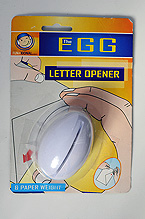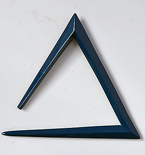







Envelope Openers, Not Letter Openers!
The art of letter writing is in decline, but that's not stopping the number of new and innovative designs for envelope openers, writes Ian Spellerberg.
Letter writing in the nineteenth century was an art. The letter was written on one side of a single sheet of paper and on some occasions the most was made of the space by cross-hatching (cross-writing). They were not the easiest of letters to read. The sheet of paper was then folded and creased (with a paper folder) and a blob of molten sealing wax held the folds of the letter in place.
The recipient of the letter then had the task of breaking the wax with their fingers, or a knife or a sealing wax chisel. Lists of office sundries in 1855 list 'seal chisels' but few examples survive and they are difficult to distinguish from button hole chisels. The alternative was to cut the seal out with a pair of scissors. By the way, there was no such thing as a sealing wax hammer. What are often sold as sealing wax hammers are in fact small domestic ice picks.
Now we come to envelopes and envelope openers. I deliberately don't use the term 'letter opener' because the letter is in the envelope and it's the envelope (not the letter) that is opened. Indeed, most of the early patented designs mention envelope openers.
Envelopes became available in America and Britain in the 1840s but in England the widespread use of envelopes for letters was discouraged because of postal costs. The envelopes at that time were more like a wrapper and were sealed with wax or a wafer.
By the 1860s envelopes with sealable flaps were becoming widely accepted. Not surprisingly, the age of the envelope opener was beginning to dawn. Looking at registered patents for envelope openers before 1930 (from the USA, Canada, Britain, France, Germany and Austria), I was surprised at how similar the methods and designs were between the countries.
The first and perhaps obvious answer to opening an envelope was to redesign the envelope so that it could be opened by pulling a flap and tearing a narrow strip of paper away from the envelope. It was an idea that is still with us today. Similar in design was to have a thread of string partly embedded in the paper - pulling on the end of the twine ripped open the envelope. One curious patent (there are always 'curious' patents to be found) proposed that a specially shaped piece of light card was sealed with the letter. It had a tab that protruded from the top of the envelope and a pull on the tab forced the card through the top of the envelope. The first two examples were certainly adopted and no doubt any surviving early examples would make an exciting addition to a collection of postal ephemera.
Next to appear were hand held 'devices' for slipping into the flap of the envelope and cutting the top open. One example was the Charles B. Stephens envelope opener patented in 1869. It included a pencil eraser and an ink eraser. On thinking about such a simple answer, it reminded me of the number of occasions I have seen envelopes being ripped apart with a thumb, or bread-knife and anything long, narrow and sharp. Such methods of opening envelopes seem contrary to the gentle art of letter writing and the etiquette that went with it.
The simplest patented design for a hand held letter opener was nothing more than a pressed piece of thick wire with a loop at the end for a handle. But wait, why have a hand-held envelope opener when you could have one attached to your finger or attached to your desk? Can you just imagine the health and safety inspector's reaction to such devices?
Such early designs were just the start and this is where we enter into the popular realm of collecting envelope openers. The design of letter openers from the late nineteenth century through to the early twentieth century went through several design periods and styles in all the different countries.
There are the clever designs for multi-tools where the envelope opener is just one function. Erasers, stamp moisteners, measuring tapes, cigarette lighters, bottle openers, letter scales, magnifying glasses, calendars, staplers, nail clippers and files have at some stage all been combined with an envelope opener. The ultimate example (from the 1870s and one that I have never seen) was said to combine an envelope opener with a pen, pencil holder, ear spoon, finger cleaner, toothpick and pencil sharpener!
During the twentieth century, souvenir envelope openers were made in the millions. They are commonly to be found at fairs, second hand shops and antique markets. Many are not expensive, but it's a wonderful and inexpensive way of starting a collection and an historical way of tracing the ever-evolving business interests in any country or city as many envelope openers were used for advertising. Then there are of course animal, plant and famous people themes. Finally there were some that were just works of art.
Hand-held envelope openers have sometimes been confused with other writing accessories. For example, envelope openers are not the same as paper-knives (paper cutters). They have different histories, functions and designs. Paper-knives have a much older history and were used to cut paper and the uncut pages of books, magazines and newspapers.
Mechanical envelope openers and envelope opening machines quickly appeared after the invention of hand-held envelope openers. There are hundreds of registered patents, but few seem to have survived. One suitably named mechanical example was the 'lightning letter opener' from around 1912 to 1918. Other mechanical examples included small guillotines for cutting paper and cardboard.
Going from the patent designs, envelope opening machines were large and complex. Presumably they were designed to open many envelopes in as short a space of time as possible.
Old hand-held envelope openers may seem to be a thing of the past, but what is so interesting is that designers from around the world are currently creating simple and beautiful examples. What's particularly exciting is that many of the designs are not the 'typical' dagger-like shape - they are far removed from the straight and narrow. How about an envelope opener in the shape of an egg, or in the shape a triangle! An extremely striking example is the lightning bolt shape from Greece. One example that stands out is the envelope opener in the shape of an owl. It was a design that I had to have.
So the art of letter writing may be in decline but the number of new designs for envelope openers is increasing. They are the collectables of the future, spanning decades, styles and design periods. Envelope openers are an art form and they don't have to be old to be collectable. Indeed, the new compliments the old!
Further reading: Kurt F. Buchel (Letter openers - works of art on a desk), Books on Demand GmbH (Germany). Ian Spellerberg (Reading and Writing Accessories - a study of paper-knives, paper folders, letter openers and mythical page turners), Cadsonbury Publications (New Zealand) and Oak Knoll Press (USA).
This feature first appeared in the Winter 2017 issue of Antiques and Collectables for Pleasure & Profit.